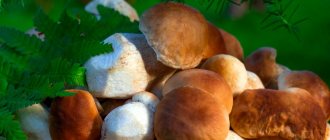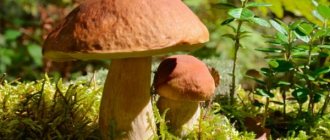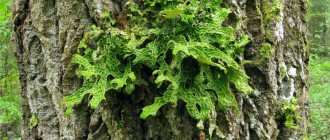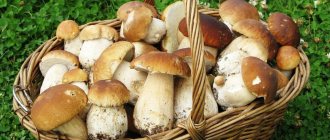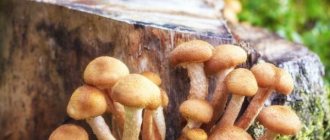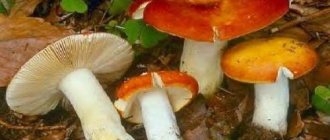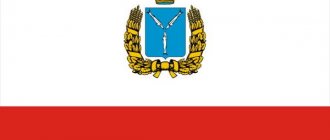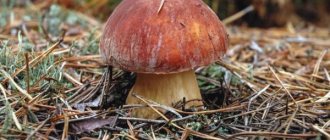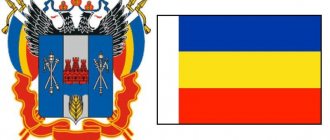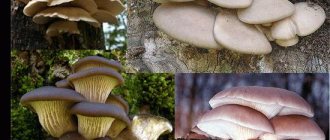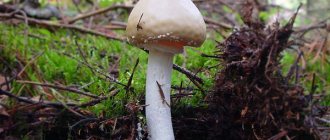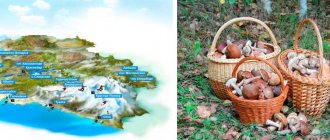There are more than 62 species of mushrooms in the Leningrad region. This is a great place for a mushroom picker to roam. But along with porcini mushrooms and chanterelles, you can encounter poisonous species, encountering which will not bring anything good.
There are only 8 poisonous mushrooms in the Leningrad region (registered), but nevertheless, every mushroom picker should know about them.
In the article you will learn about what poisonous mushrooms are found in this area, and you will see photos and descriptions of each species.
Fly agaric red
The fruiting body contains a number of toxic substances that have a psychotropic effect (refers to psilocybin mushrooms).
Among these substances:
- Ibotenic acid. During drying of the fruiting body, it turns into muscimol. These substances are very toxic and affect the brain, causing the death of its cells.
- Muscarine. When a large amount of a substance enters the body, poisoning occurs. It is accompanied by a number of symptoms: nausea, vasodilatation, involuntary salivation, sweating, vomiting, etc. Also, suffocation and even death may occur.
- Muskazon. It is a breakdown product of ibotenic acid. It has little effect on the human body, since its content in the fruiting body is minimal.
It is worth noting that people do not die from fly agarics. And this is explained by two factors:
- Firstly, this mushroom is easy to distinguish from other edible ones. Therefore, it very rarely ends up in human mushroom baskets.
- Secondly, after heat treatment the amount of toxic substances is sharply reduced. To cause death, a person must eat at least 15 Amanita caps.
Tips for beginner mushroom pickers
You can only put in the basket those specimens whose edibility there is not the slightest doubt. And even the most beautiful, strong and stately mushroom should be avoided if it is unknown to the collector. Inspection of the crop should be carried out not only in the forest, but also at home, if necessary, comparing the characteristics of suspicious fruits with encyclopedic or online data.
Important!
If at least one sign indicates that the mushroom is false, then it should be thrown away immediately. In addition, it is strongly recommended not to collect fruits along busy highways or near hazardous industries, since mushrooms growing in this area tend to absorb all exhaust and toxins.
And even if they belong to the edible category, it’s not worth the risk, since fruiting bodies tend to accumulate harmful substances.
Before picking mushrooms in the forest, it is important to pay attention to the warnings and signs that are often posted near the forest belt, as they may contain useful information for mushroom pickers.
Death cap
Inexperienced mushroom pickers very often confuse Pale toadstool with champignon, green russula and greenfinch. It should be noted that the plates of champignons color very quickly, and the same russulas do not have a ring on their stem. The Greenfinch is also quite different from the Pale Grebe: it has no ring, no green plate and no volva.
This mushroom is incredibly toxic. Just ¼ of the cap can cause severe poisoning. Moreover, unlike other poisonous fruiting bodies, the concentration of toxic substances in the composition does not decrease even with heat treatment.
Amanita stinking
He is also the White Grebe. Deadly poisonous mushroom. In terms of symptoms and danger, it resembles the Pale Toadstool. As with the Pale Toadstool, the White Toadstool can be confused with mushrooms.
We recommend reading: “Edible mushrooms of the Leningrad region”
Poisoning is severe, often resulting in death. Champignon can be easily distinguished from the poisonous Amanita by the absence of a volva and colored plates.
Where are dangerous mushrooms distributed in the Leningrad region?
Poisonous species of mushrooms can be found throughout the region. But the likelihood of putting them in a basket along with edibles is greater in popular “silent hunting” places:
- In the Volkhov district (village Kolchanovo).
- In the Vsevolzhsky district (microdistrict Vsevolzhsk - Berngardovka).
- In the Vyborg region (Vyborg).
- In the Gatchina region (Vyritsa village).
- In the Kurortny district (Dibuny station).
- In the Kirovsky district (Sinyavino village, Gory village).
- In the Lodeynopolsky district (Alekhovshchina village).
- In the Priozersky district (the villages of Borisovo, Kommunary, Kuznechnoye, Losevo, Michurinskoye, Snegirevka, Sosnovo).
| Name of the mushroom | Where to find |
| Death cap | It is found singly or in groups, mainly on fertile soils, in well-lit deciduous forests, next to beech, oak and hazel. Can grow in mixed forests. The grebe likes cool and dark places |
| Red champignon | Mainly grows in deciduous and mixed forests. Happens in meadows, gardens and parks |
| Panther fly agaric | With all the abundance of coniferous and deciduous trees, it stays close to pine, oak or beech. Selects predominantly alkaline soils |
| Fly agaric white | It grows singly or in groups in moist mossy areas of spruce, mixed and deciduous forests, forming a symbiotic relationship with oak, birch and alder. It can only be found in wooded areas with plenty of shade. Loves chalky soil |
| Galerina bordered | Lives in forests of various types. Alone or in groups, it “climbs” coniferous (sometimes deciduous) trees. It also grows on underground wood |
| The most beautiful cobweb | Prefers oak and pine forests. Often located near a spruce tree |
| Satanic mushroom | In deciduous (less often mixed) forests it can be found next to beech and oak, hornbeam, hazel, linden and chestnut. Prefers calcareous soils |
Carmine red spiderwort
It is deadly poisonous. It contains the substance orellanin, which has a serious effect on the liver. A characteristic feature of cobweb poisoning is the late onset of symptoms. There were often cases when symptoms appeared 24 days after eating the fruiting bodies.
Heat treatments do not reduce the concentration of toxic substances in the Cobweb.
Another interesting fact is that until 1960 this mushroom was considered harmless. But in Poland, most people who ate it experienced poisoning, often leading to death.
During chemical analysis, it became clear that this mushroom is not only inedible, but also completely poisonous.
The main types of poisonous mushrooms in the Leningrad region
In order not to make a mistake in choosing under natural conditions, it is important to study the main features of the most dangerous mushrooms in the region.
Death cap
An extremely dangerous representative of the hat-footed species. Similar to green or yellow russula, as well as champignons. Young fruiting bodies are ovoid in shape and completely covered with a film. The cap of adults grows to 5-15 cm and transforms from a hemispherical shape to a flatter one. The surface is fibrous, the edge is smooth. The color is whitish-olive, becoming grayer over time. There are no spots or scales. The plates are soft, freely arranged, white.
On a cylindrical leg (often with moiré patterns) 1-2.5 cm thick and 8-16 cm high, a fringed membranous ring is initially present, but then it often disappears. The color of the leg is white from above to the ring, greenish below. The leg has a thickened, sac-like base, 3 to 5 cm wide. The white, fleshy pulp of a young mushroom does not have a pronounced odor, but an old one smells unpleasant.
Any type of treatment will not neutralize its deadly poison. The main signs of poisoning are nausea, gag reflexes, muscle pain, bloody diarrhea, liver damage (jaundice).
Red champignon
First of all, its poisonous essence is revealed by an unpleasant odor similar to phenol. It may not be detected immediately, but during cooking it becomes evident.
The fleshy white-brown cap becomes bell-shaped as it grows from round. It can be 5-15 cm in diameter. The edge is slightly bent and may crack. The surface is smooth and dry. An important feature is that the mushroom turns yellowish when pressed. The thin plates are initially white or pinkish, but turn brown as they mature.
The white hollow stalk, swollen at the base, grows up to 6-15 cm in height and 1-2 cm in width. When cut at the base of the mushroom, you can find a bright yellow-chrome zone. There is a two-layer film ring.
Eating red champignon leads to mild poisoning. Toxins negatively affect only the digestive system. Poisoning is accompanied by constant pain in the stomach. Headaches, dizziness, nausea, vomiting and diarrhea may occur.
You may be interested in:
Names and descriptions of poisonous mushrooms of Crimea (30 photos) When going into the forest for a quiet hunt, you should familiarize yourself not only with edible fruits, but also with poisonous representatives...Read more...
Panther fly agaric
This fly agaric contains toxins that are inherent in henbane, dope and other poisonous plants. Researchers claim that it is more dangerous than its red relative. It contains hyomycin, which can cause death. With mild poisoning, a person experiences attacks of aggression and hallucinations.
This fly agaric is notable for its white warts (remnants of the veil), which are dispersed over a light, dark or gray-brown (sometimes olive) cap measuring 7-12 cm. The central part of the cap is darker. The shape is first round-convex, then semi-prostrate. The plates under the cap are white. They expand closer to the periphery.
The stalk, narrowed at the top and thicker at the bottom, has an average thickness of 1-1.5 cm and rises 6-10 cm. It has rows of warts and a thin, striped, sagging white ring, which disappears in old mushrooms. You can also distinguish the panther mushroom from others thanks to the collar volva at the base. The white flesh of the mushroom emits an unpleasant odor.
Amanita White
The white fly agaric, also called the stinky fly agaric because of its bleach-like odor, contains the same toxins as the toadstool. In the Leningrad region it often comes across, and novice mushroom pickers may mistake it for a champignon, white float, white umbrella mushroom or white russula, especially in the initial stage of development. First of all, you need to focus on the smell.
In accordance with the “speaking” name, this fly agaric is all white. young fly agarics have a hemispherical or conical (with a sharp tip) cap shape. Over time, it becomes convex. Its size ranges from 6 to 11 cm. The surface is sticky, shiny, slimy, covered with filmy flakes. The edges of the cap are slightly ribbed. The plates are frequent, loose and soft, white, do not darken.
The cylindrical leg, 10-15 cm high and 0.7-2.5 cm thick, is covered with a flocculent coating, hollow inside, thickened in the lower part, covered by a free cup-shaped volva, reaching 3 cm in diameter. From the remains of the bedspread in the upper part of the leg there is a wide silky white ring with a striped pattern. It disappears in older mushrooms.
Galerina bordered
Bordered galerinas and pale grebes have almost the same toxins, but only in the former the poison is in lower concentration. They look like summer mushrooms. Galerina fringed loves coniferous forests, so it is better not to look for honey mushrooms there.
The mushroom has a small (2-5 cm) brown cap with a yellowish tint, the shape of which varies from bell-shaped and convex to flat. Translucent grooves of the plates are visible at the top along its edges. Plates of medium frequency and width descend onto the stem.
At first they are light (yellowish or ocher), but when the spores ripen, they become reddish-brown, brownish-rusty. The leg is thin (0.1-0.5 mm), but not high (4-5 cm), hollow inside. In the upper part there is a white or yellow ring, which disappears with age. From the cap to it, the leg is covered with a powdery coating. The pulp is yellow-brown. It is lighter in color and has a faint powdery odor.
You may be interested in:
How to identify mushrooms: edible and inedible (33 photos) At the beginning of each mushroom season, the number of lovers of “silent hunting” increases. This is an interesting activity, but in some cases...Read more...
The most beautiful cobweb
In late autumn, beautiful spider webs appear in large numbers. Spider web toxins cause kidney failure. By the way, they act slowly. This is the danger: signs of poisoning appear 1-2 weeks after consumption.
If you do not respond in time, death is possible. There are no similar edible species. If we compare them with honey mushrooms, it should be noted that poisonous lamellar mushrooms have ocher belts on the stem. The color of their plates is almost cherry-red, while that of honey mushrooms is white or yellowish.
The size of a mature cap of the most beautiful one ranges from 3-8 cm. At first it is conical or bell-shaped, then flat-convex with a blunt tubercle in the center. The color of the velvety-fibrous (sometimes with scales) surface of the cap ranges from reddish-brown to reddish-brown. Relatively rare plates of ocher-brown (later rusty-brown) color grow together with a long (5-12 cm) and thin (0.5-1.5 cm) stalk. The leg is cylindrical, slightly thickened at the base, with veil belts. Its surface is fibrous. The flesh of the mushroom is orange or yellow.
Satanic mushroom
Not all researchers believe that eating satanic mushroom is dangerous - after cooking, the concentration of toxins decreases to an acceptable level.
Important!
It should be borne in mind that without prolonged soaking and cooking for less than 10 hours, there is a risk of serious poisoning of the body. Death is also possible.
The mushroom looks impressive. The hemispherical fleshy cap can grow from 8 to 25 cm in diameter, gradually becoming more prostrate. Dry to the touch, may be velvety or smooth. Color - white or dirty grayish. A yellow tint and faint green stains are possible. The tubular layer of young fruiting bodies is yellow, while that of mature ones is yellow-green. Small yellow pores gradually acquire a reddish color, and when pressed they turn blue.
The dense, massive, barrel-shaped leg, reaching 3-9 cm in thickness and 5-15 in height, has a pronounced mesh pattern with rounded cells. It is narrowed at the top and yellow-red. In the middle part - red-orange, below - yellow-brown. The pulp is white, creamy. It turns red and blue when cut. The smell of ripe mushrooms resembles the stench of sour foods and rotten onions. Young people may not smell.
